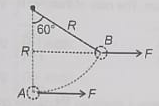A block of mass m is pulled along a circular arc by means of a constant horizontal force F as shown. Work done by this force in pulling the block from A to B is

1.
2. FR
3. FR
4. mgR

A particle is displaced from a position metre to another position metre under the action of force N. Work done by the force is
1. 8 J
2. 10 J
3. 12 J
4. 36 J
A string is used to pull a block of mass m vertically up by a distance h at a constant acceleration . The work done by the tension in the string is

1.
2.
3.
4.
Work done by frictional force
1. is always negative
2. is always positive
3. is zero
4. May be positive, negative or zero
Two bodies of masses m1 and m2 have same kinetic energy. The ratio of their momentum is
1.
2.
3.
4.
Two bodies of masses m1 and m2 have same momentum. The ratio of their KE is
1.
2.
3.
4.
Two bodies of masses m1 and m2 are moving with same kinetic energy. If P1 and P2 are their respective momentum, the ratio is equal to
1.
2.
3.
4.
A particle moves along X-axis from x=0 to x=1 m under the influence of a force given by . Work done in the process is
1. +4 J
2. -4 J
3. +8 J
4. -8 J
Under the action of a force, a 2 kg body moves such that its position x as a function of time t is given by , where x is in metre and t in second. The work done by the force in first two seconds is
1. 1600 J
2. 160 J
3. 16 J
4. J
KE acquired by a mass m intravelling a certain distance d, starting from rest, under the action of a constant force F is
1. Directly proportional to
2. Directly proportional to m
3. Directly proportional to
4. None of these






